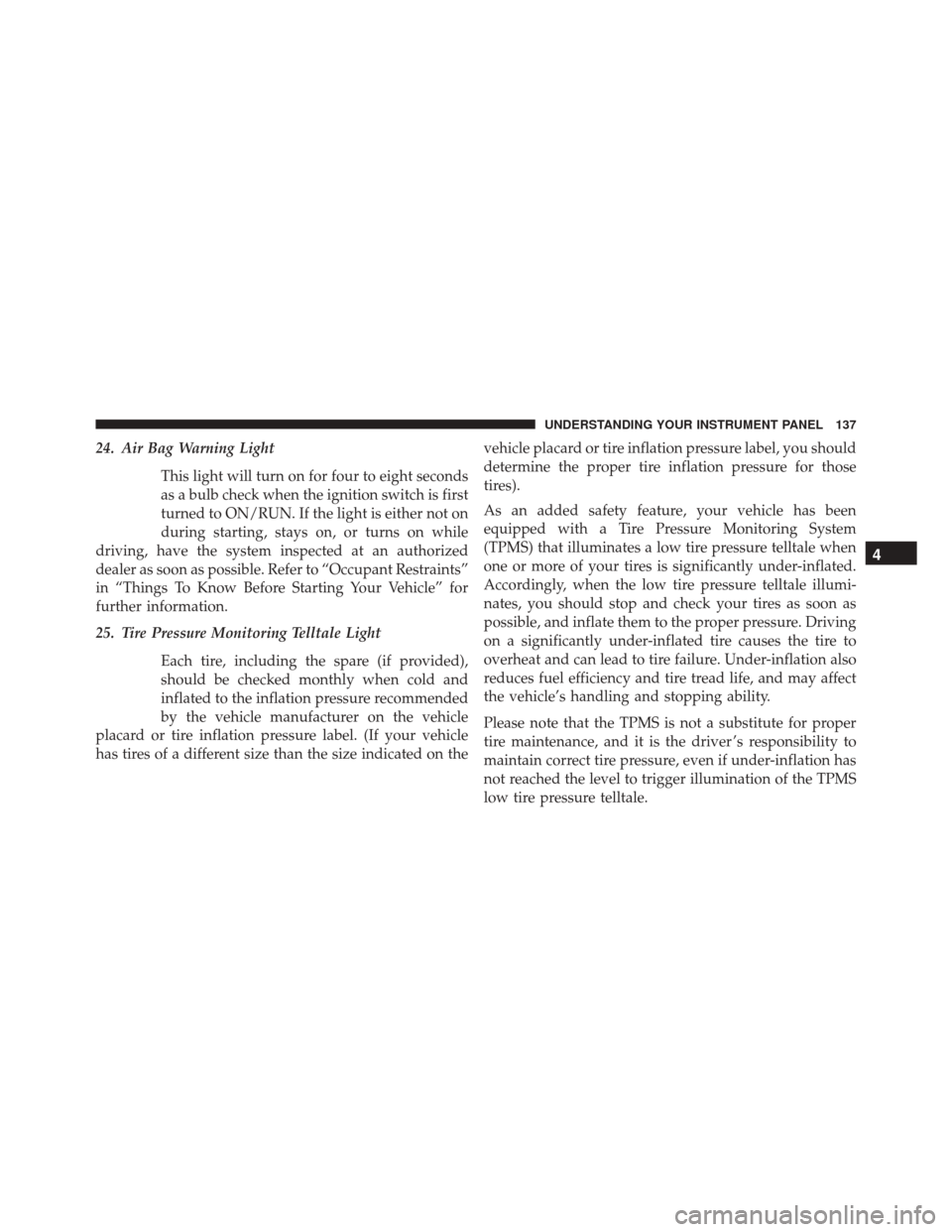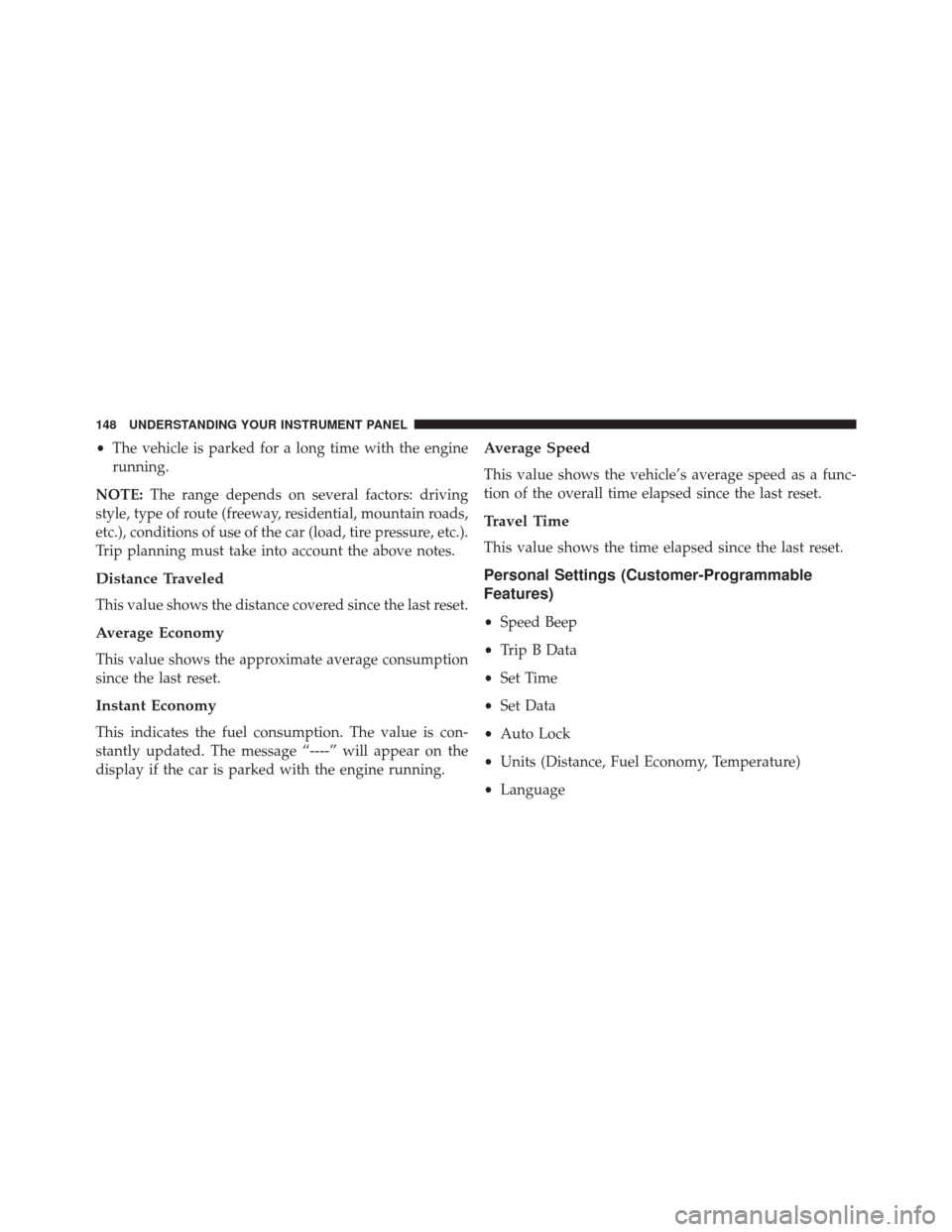Page 138 of 425

20. TOW/HAULThis light will illuminate when TOW HAUL
mode is selected.
21. Low Fuel Light
When the fuel level reaches approximately 3.0 gal (11.7
L), this light will turn on, and remain on until fuel is
added.
22. Fuel Gauge/Fuel Door Reminder When the ignition switch is in the ON/RUN
position, the pointer will show the level of fuel
remaining in the fuel tank. The fuel pump
symbol points to the side of the vehicle where
the fuel door is located. 23. Generic Warning Light
The Generic Warning Light will illuminate if
any of the following conditions occur:
• Air Bag Warning Light Fault
• Engine Oil Pressure Sensor Failure
• Fuel Cut Off Intervention/Fail
• Parking Assistance Failure
• Engine Minimum Oil Level
• Engine Minimum Oil Pressure Fail
• Electronic Park Brake Fail Fixed — If Equipped
• Electronic Park Brake Inspection — If Equipped
• Electronic Park Brake Maintenance — If Equipped
• Electronic Park Brake Sensor Fail — If Equipped
• Swivel Seat Malfunction
136 UNDERSTANDING YOUR INSTRUMENT PANEL
Page 139 of 425

24. Air Bag Warning LightThis light will turn on for four to eight seconds
as a bulb check when the ignition switch is first
turned to ON/RUN. If the light is either not on
during starting, stays on, or turns on while
driving, have the system inspected at an authorized
dealer as soon as possible. Refer to “Occupant Restraints”
in “Things To Know Before Starting Your Vehicle” for
further information.
25. Tire Pressure Monitoring Telltale Light
Each tire, including the spare (if provided),
should be checked monthly when cold and
inflated to the inflation pressure recommended
by the vehicle manufacturer on the vehicle
placard or tire inflation pressure label. (If your vehicle
has tires of a different size than the size indicated on the vehicle placard or tire inflation pressure label, you should
determine the proper tire inflation pressure for those
tires).
As an added safety feature, your vehicle has been
equipped with a Tire Pressure Monitoring System
(TPMS) that illuminates a low tire pressure telltale when
one or more of your tires is significantly under-inflated.
Accordingly, when the low tire pressure telltale illumi-
nates, you should stop and check your tires as soon as
possible, and inflate them to the proper pressure. Driving
on a significantly under-inflated tire causes the tire to
overheat and can lead to tire failure. Under-inflation also
reduces fuel efficiency and tire tread life, and may affect
the vehicle’s handling and stopping ability.
Please note that the TPMS is not a substitute for proper
tire maintenance, and it is the driver ’s responsibility to
maintain correct tire pressure, even if under-inflation has
not reached the level to trigger illumination of the TPMS
low tire pressure telltale.
4
UNDERSTANDING YOUR INSTRUMENT PANEL 137
Page 150 of 425

•The vehicle is parked for a long time with the engine
running.
NOTE: The range depends on several factors: driving
style, type of route (freeway, residential, mountain roads,
etc.), conditions of use of the car (load, tire pressure, etc.).
Trip planning must take into account the above notes.
Distance Traveled
This value shows the distance covered since the last reset.
Average Economy
This value shows the approximate average consumption
since the last reset.
Instant Economy
This indicates the fuel consumption. The value is con-
stantly updated. The message “----” will appear on the
display if the car is parked with the engine running.
Average Speed
This value shows the vehicle’s average speed as a func-
tion of the overall time elapsed since the last reset.
Travel Time
This value shows the time elapsed since the last reset.
Personal Settings (Customer-Programmable
Features)
• Speed Beep
• Trip B Data
• Set Time
• Set Data
• Auto Lock
• Units (Distance, Fuel Economy, Temperature)
• Language
148 UNDERSTANDING YOUR INSTRUMENT PANEL
Page 201 of 425

�TIRE CHAINS (TRACTION DEVICES) .......254
� TIRE ROTATION RECOMMENDATIONS .....256
� TIRE PRESSURE MONITORING SYSTEM
(TPMS) ............................. .257
▫ Base System ........................ .259
▫ General Information ...................261
� FUEL REQUIREMENTS ..................262
▫ 3.6L Engine ..........................262
▫ Reformulated Gasoline .................262
▫ Gasoline/Oxygenate Blends ..............263
▫ E-85 Usage In Non-Flex Fuel Vehicles .......263
▫ MMT In Gasoline .....................264
▫ Materials Added To Fuel ................264
▫ Fuel System Cautions ...................265 ▫
Carbon Monoxide Warnings .............266
� ADDING FUEL ........................266
▫ Fuel Filler Cap (Gas Cap) ...............266
▫ Loose Fuel Filler Cap Message ............268
� VEHICLE LOADING ....................269
▫ Vehicle Certification Label ...............269
� TRAILER TOWING .....................271
▫ Common Towing Definitions .............272
▫ Towing Tips ........................ .282
� RECREATIONAL TOWING
(BEHIND MOTORHOME, ETC.) ............283
▫ Towing This Vehicle Behind Another Vehicle . .283
▫ Recreational Towing — Automatic
Transmission ........................ .284
5
STARTING AND OPERATING 199
Page 245 of 425

WARNING!(Continued)
•Always drive with each tire inflated to the recom-
mended cold tire inflation pressure.
Both under-inflation and over-inflation affect the stability
of the vehicle and can produce a feeling of sluggish
response or over responsiveness in the steering.
NOTE:
• Unequal tire pressures from side to side may cause
erratic and unpredictable steering response.
• Unequal tire pressure from side to side may cause the
vehicle to drift left or right.
Fuel Economy
Underinflated tires will increase tire rolling resistance
resulting in higher fuel consumption.
Tread Wear
Improper cold tire inflation pressures can cause abnor-
mal wear patterns and reduced tread life, resulting in the
need for earlier tire replacement.
Ride Comfort And Vehicle Stability
Proper tire inflation contributes to a comfortable ride.
Over-inflation produces a jarring and uncomfortable
ride.
Tire Inflation Pressures
The proper cold tire inflation pressure is listed on the
driver’s side B-Pillar or rear edge of the driver’s side
door.
5
STARTING AND OPERATING 243
Page 261 of 425

NOTE:
•The TPMS is not intended to replace normal tire care
and maintenance, or to provide warning of a tire
failure or condition.
• The TPMS should not be used as a tire pressure gauge
while adjusting your tire pressure.
• Driving on a significantly under-inflated tire causes
the tire to overheat and can lead to tire failure.
Under-inflation also reduces fuel efficiency and tire
tread life, and may affect the vehicle’s handling and
stopping ability.
• The TPMS is not a substitute for proper tire mainte-
nance, and it is the driver ’s responsibility to maintain
correct tire pressure using an accurate tire gauge, even
if under-inflation has not reached the level to trigger
illumination of the Tire Pressure Monitoring Telltale
Light. •
Seasonal temperature changes will affect tire pressure,
and the TPMS will monitor the actual tire pressure in
the tire.
Base System
This is the TPMS warning indicator located in the
instrument cluster.
The TPMS uses wireless technology with wheel rim
mounted electronic sensors to monitor tire pressure lev-
els. Sensors, mounted to each wheel as part of the valve
stem, transmit tire pressure readings to the Receiver
Module.
NOTE: It is particularly important for you to check the
tire pressure in all of the tires on your vehicle regularly
and to maintain the proper pressure.
5
STARTING AND OPERATING 259
Page 272 of 425

WARNING!
Because the front wheels steer the vehicle, it is
important that you do not exceed the maximum front
or rear GAWR. A dangerous driving condition can
result if either rating is exceeded. You could lose
control of the vehicle and have a collision.
Tire Size
The tire size on the Vehicle Certification Label represents
the actual tire size on your vehicle. Replacement tires
must be equal to the load capacity of this tire size.
Rim Size
This is the rim size that is appropriate for the tire size
listed.
Inflation Pressure
This is the cold tire inflation pressure for your vehicle for
all loading conditions up to full GAWR.
Curb Weight
The curb weight of a vehicle is defined as the total weight
of the vehicle with all fluids, including vehicle fuel, at full
capacity conditions, and with no occupants or cargo
loaded into the vehicle. The front and rear curb weight
values are determined by weighing your vehicle on a
commercial scale before any occupants or cargo are
added.
Overloading
The load carrying components (axle, springs, tires,
wheels, etc.) of your vehicle will provide satisfactory
service as long as you do not exceed the GVWR and the
front and rear GAWR.
270 STARTING AND OPERATING
Page 367 of 425
CavityMaxi Fuse Mini Fuse Description
F07 50 Amp Red (non
A/C)
60 Amp Blue (A/C) Engine Cooling Fan - 1st Speed
F08 40 Amp Orange Passenger Compartment Blower
F09 15 Amp Blue Rear Power Outlet
F10 15 Amp Blue Horn
F11 15 Amp Blue Fuel Pressure Regulator (MPROP)-DRV
(3.0 Diesel Engine) — If Equipped
F14 20 Amp Yellow Power Outlet
F15 7.5 Amp Brown USB Charger
F16 7.5 Amp Brown KL15 Shifter Transmission Module
(STM) (3.6), KL15 Starter Relay Coil (3.6
Gasoline Engine)
7
MAINTAINING YOUR VEHICLE 365